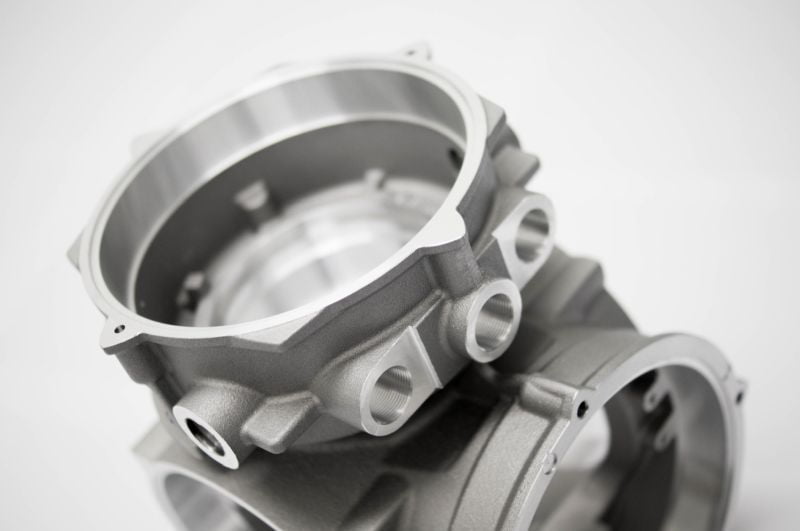Published - 24th Jul 2024
Choosing aluminium alloys for sand casting can be confusing. Aluminium alloys produce components that are lightweight but strong, can operate at extreme temperatures and have excellent corrosion resistance. But there is a wide range of available alloys from which to choose.
At Haworth Castings we specialise in sand casting aluminium alloys to produce high-quality components for a wide range of industries, including aerospace, defence, energy and transportation. In this blog, we’ll look at these versatile metals and how to choose the right aluminium alloy for your application.

Aluminium is a silvery-white, non-magnetic metal. It is lightweight, soft and malleable.
Aluminium is the most abundant metal in the Earth’s crust (8%). However, it does not occur naturally in its pure form, only combined with oxygen and other elements.
Sir Humphry Davy, the Cornish chemist who identified the existence of a metal base to alum, named it ‘aluminum’. Only later was this standardised to the more conventional ‘ium’ ending, though Americans still use Davy’s pronunciation.
Extracting aluminium from ores such as bauxite and cryolite is energy intensive, but this is mitigated by the ease of recycling. Aluminium is now mass produced and used extensively in the manufacturing of anything from aerospace engines to medical equipment.
Aluminium has many benefits. It is:
Aluminium can be melted down and mixed with other metals in an alloying furnace to improve specific qualities in the final sand casting.
Pure aluminium is soft, but alloying it with elements such as copper, magnesium and zinc boosts its strength whilst retaining its light weight. Other aluminium alloys are chosen to increase corrosion resistance, improve electrical or thermal conductivity, or to enhance ductility. The best choice of aluminium alloy for your sand casting will depend on the application.
At Haworth Castings our experts are always happy to advise on the best choice of alloy for aluminium sand castings. Our metallurgists and design team work together to help you choose the optimum manufacturing process and materials to meet your specifications.
The ideal aluminium alloy for your sand casting will depend upon factors such as:
Aluminium alloys are identified by standard codes that reflect their chemical composition and the varying proportions of different trace metals.
The LM prefix is used in the British Standard 1490 to specify aluminium casting alloys.
LM stands for “Leicht Metall” which is German for “light metal” in the context of aluminium alloy designations. Each designation refers to the chemical composition and allowable trace elements of the alloy. For example, LM25 is an aluminium alloy with 6.5-7.5% silicon and small amounts of copper, magnesium and other elements as specified in the standard.
The two aluminium alloys most commonly used in sand casting at Haworth Castings are LM6 and LM25.
LM6 in sand casting
LM6 alloy has a high silicon content. Silicon is the single most important alloying element used in aluminium casting. LM6 aluminium alloy has:
However, a high silicon content makes LM6 difficult to machine. Simple features such as drilled holes can be added, but LM6 is not the best choice where more intricate features or close tolerance holes are specified.
LM25 in sand casting
LM25 is a good choice for aluminium sand castings where high strength is required. This aluminium alloy has:
LM25 is widely seen as a good, all-purpose alloy, and a better choice than LM6 where complex details and features need to be added to a cast component. It is widely used in the automotive industry for components such as torque wrench components and cylinder heads, and a popular choice in the marine, transport and many other industries.
Other aluminium alloys for sand casting
We can cast a wide range of aluminium alloys at Haworth Castings, including:
LM13 Offers good wearability in high temperature environments – commonly used in aerospace applications
LM31 Offers excellent mechanical properties and strength at high temperature: heat treatment may not be needed. Also offers good corrosion and shock resistance. Used for general engineering components, and large sand castings.
L99 Good fluidity, allowing thin-walled sections to be cast. Good machinability once heat treated, excellent tensile strength. High purity, producing components of superior quality.
L119 Offers a very high heat resistance. Used in many applications, from turbines to train engines.
BSL 169 Good fluidity, suitable for thin-walled castings. High strength aerospace, military, and automotive applications
Aluminium alloys provide versatile metals for sand casting. The best aluminium alloy for your component will depend largely on the individual product design and end application.
Our expert metallurgists and design team have the experience to help you in choosing aluminium alloys for sand casting, selecting the optimum aluminium alloy and casting process for your component. Call us now for our advice and quotes for sand casting aluminium alloys.
If you have a project, talk to our experienced sales team
Contact us